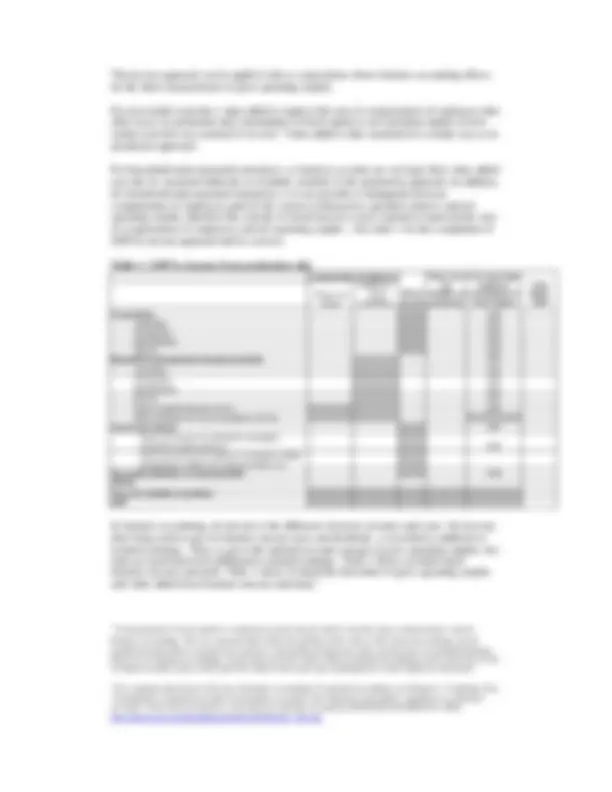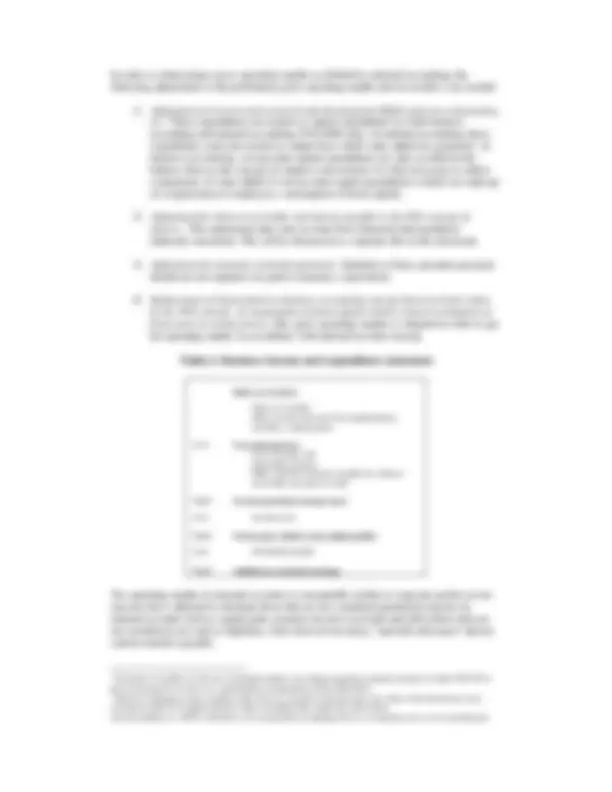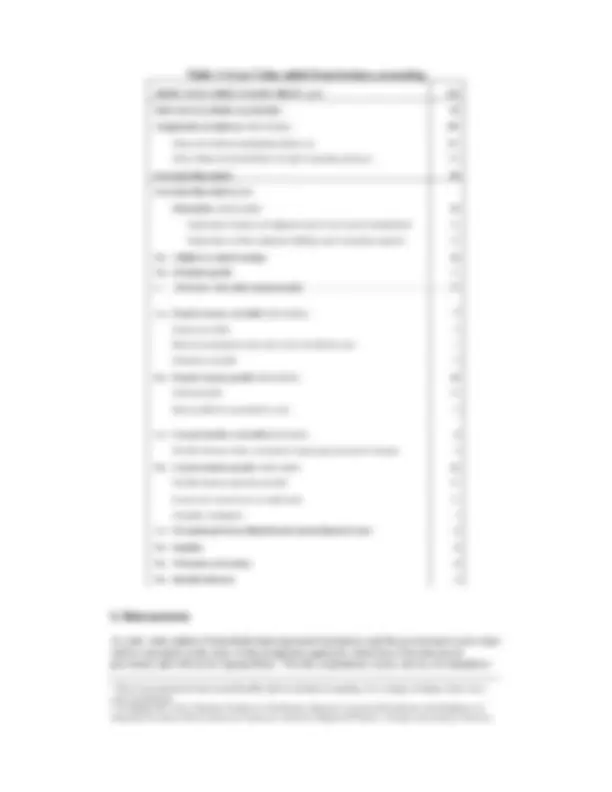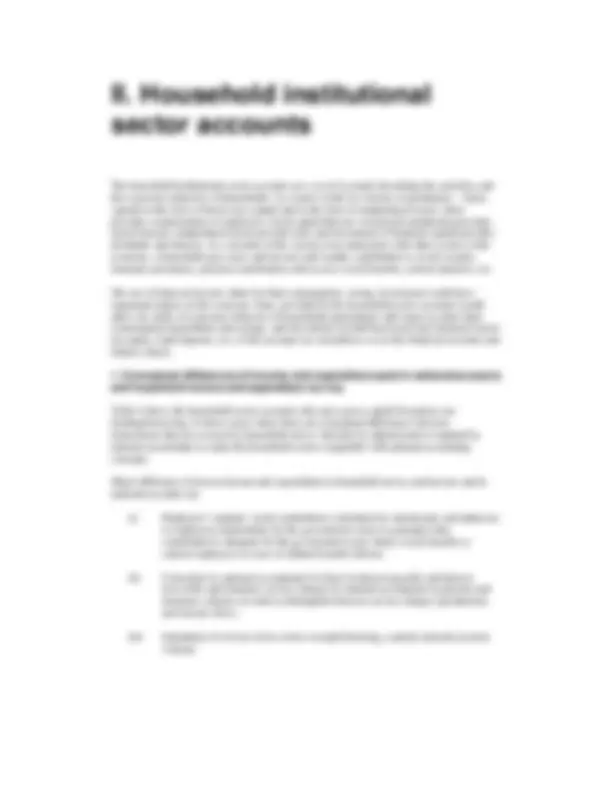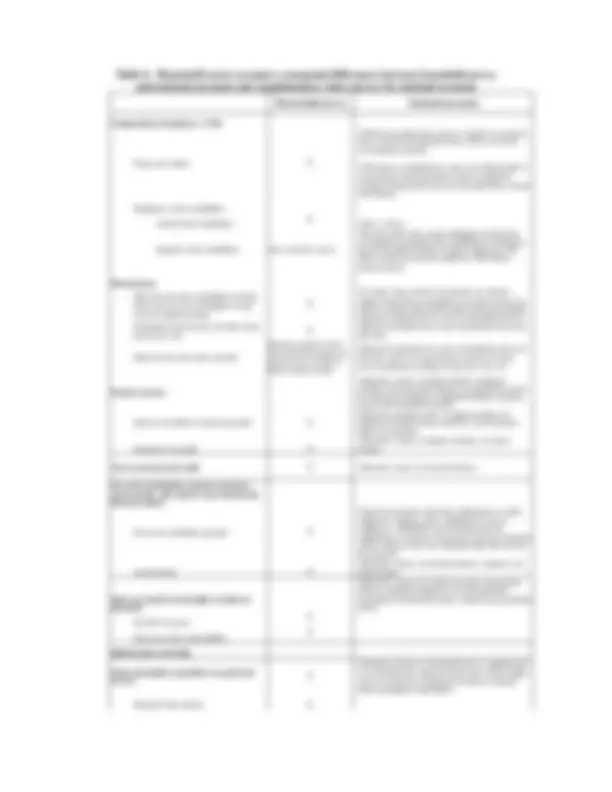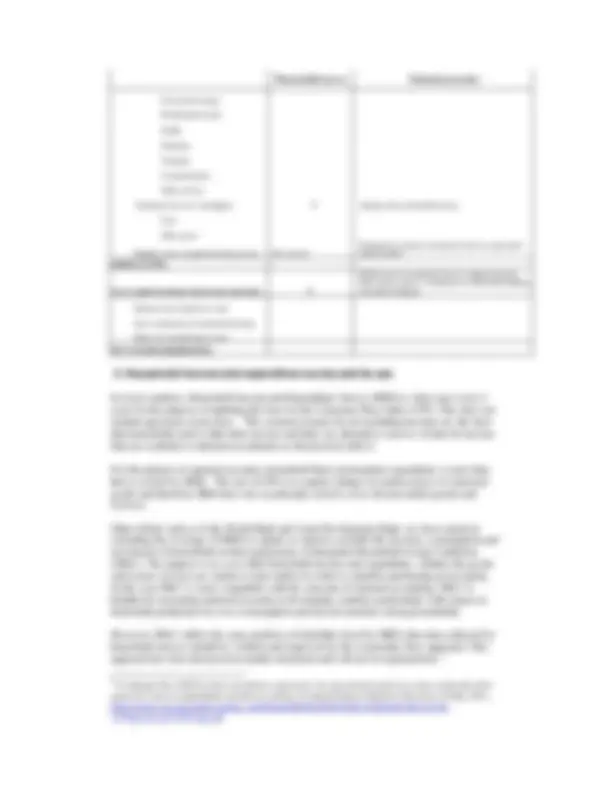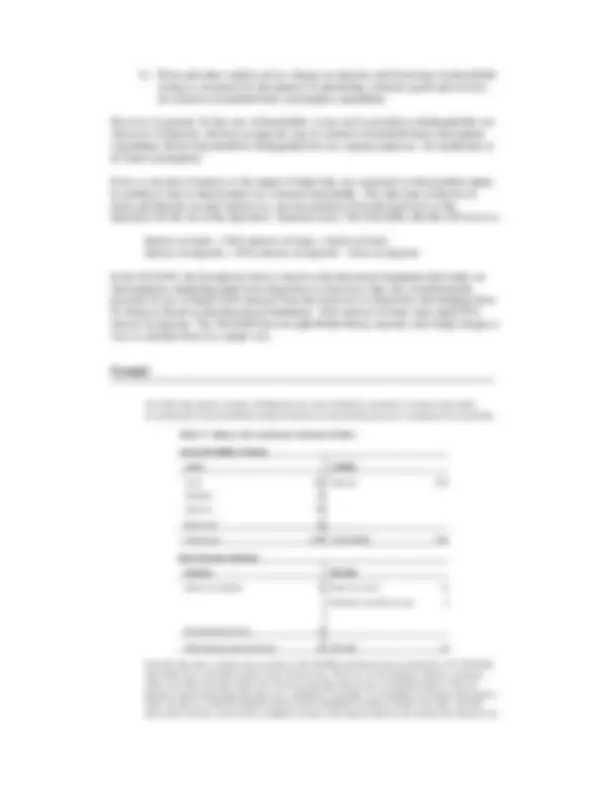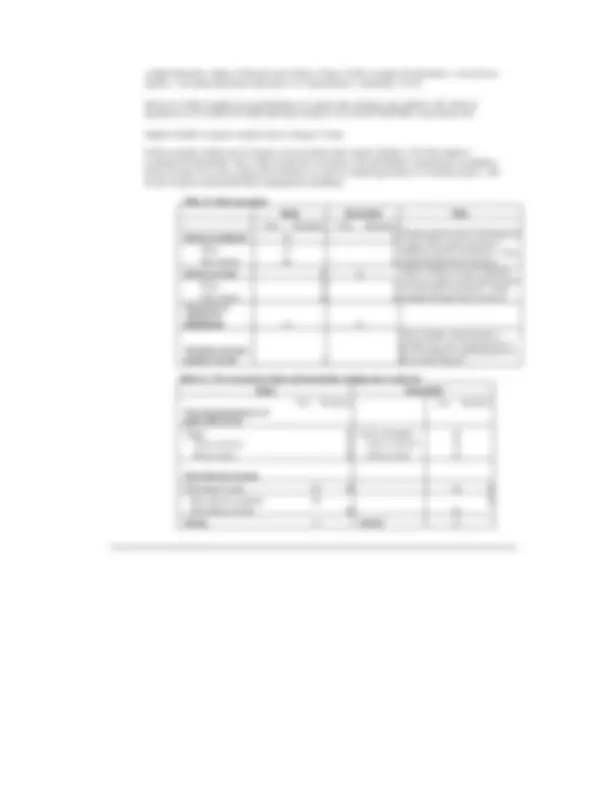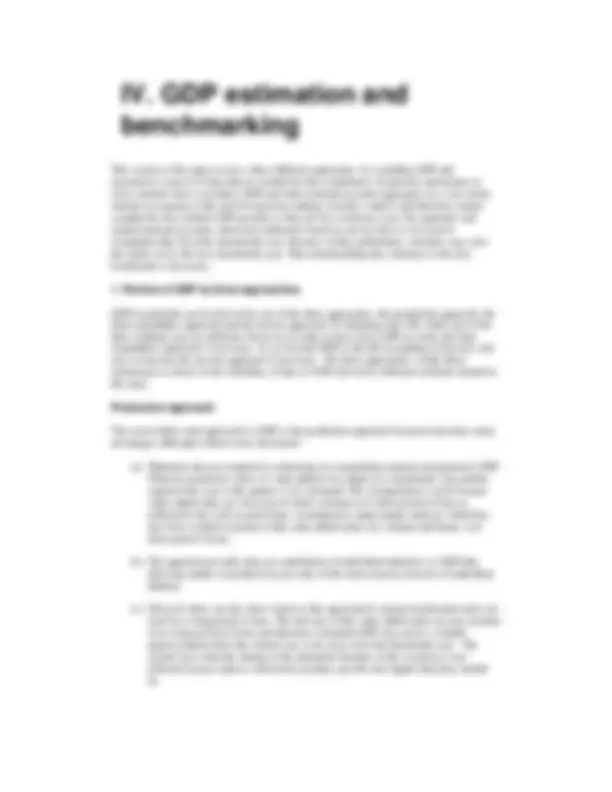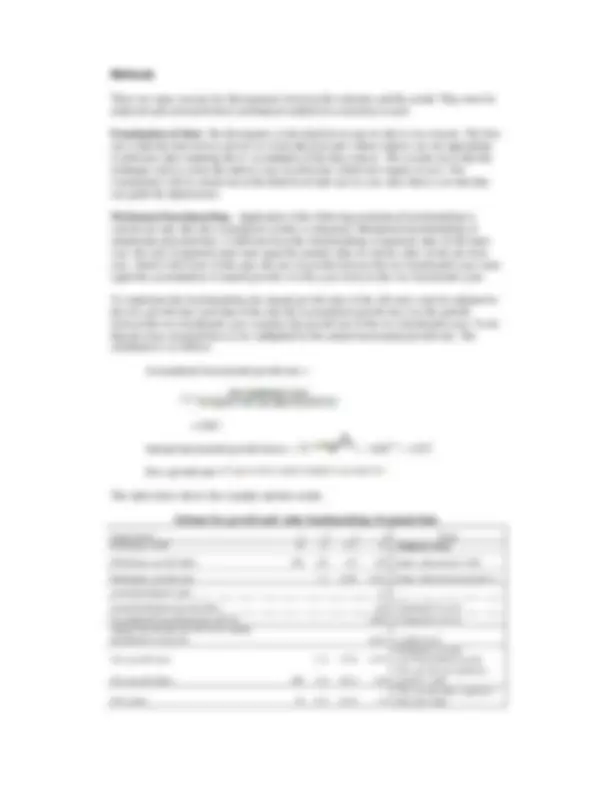Download Compilation of Household Income and GDP: Income Approach and Related Issues and more Lecture notes Statistics in PDF only on Docsity!
International Workshop on
Household Income, Consumption and Full Accounting of the
Households Sector
Beijing , China
26-28 March 2012
Back ground paper
Income approach to GDP,
and other issues relating to the compilation of
household income and consumption
expenditures
Vu Quang Viet
This paper provides a synopsis of important issues discussed in this workshop relating to
compilation of GDP by income approach, compilation of income and use of income accounts
for the household sector, review of the three compilation approaches to GDP, data sources for
the benchmark year and estimates for subsequent periods.
DEPARTMENT OF ECONOMIC AND SOCIAL
AFFAIRS
STATISTICS DIVISION
UNITED NATIONS
NATIONAL BUREAU OF STATISTICS OF
CHINA
____________________________________________________________________________________
I. GDP by income approach
This part will discuss the general characteristics of the income approach by contrasting it with
the production approach. In the income approach, it will be pointed out that the approach is
basically applied only to the corporations sector where their business accounting allows for
the direct measurement of gross operating surplus and value added. For other sectors where
either output is nonmarket like the case of the government sector, or no formal business
accounts are kept like household unincorporated sector, their value added must be measured
by the production approach.
1. General characteristics of the income approach
GDP is defined as:
GDP = Value added at basic prices + Taxes less Subsidies on products.
With the production approach, value added is measured as the difference between output (at
basic prices) and intermediate consumption (at purchasers’ prices). This is similar to
measuring gross operating surplus as residuals given data on compensation of employees
(COE), other taxes less subsidies on production activities are available. This residual
approach is applied to activities where market output can be measured. For nonmarket
activities, net operating surplus is assumed to be zero, so value added can be measured
directly as the sum of COE and consumption of fixed capital. For nonmarket activities, the
measurement of value added is similar for both the production and the income approaches.
GDP by income approach, similar to GDP by production approach, also aims at measuring
value added, but there are two fundamental differences between the two approaches.
The first one is that GDP by income approach measures GDP as the sum of all components
of value added while GDP by production approach measures value added as a residual --
the difference between gross output and intermediate consumption. By income approach,
Value added = Compensation of employees + Mixed income + Other taxes less
subsidies on production + Gross operating surplus.
With:
Gross operating surplus = Net operating surplus + Consumption of fixed capital.
Direct measurement of value added requires direct measurement of gross operating surplus ,
thus leading to the second fundamenta l difference between the two methods.
The second fundamental difference is that the statistical unit for the income approach is
the enterprise unit while the statistical unit of the production approach is the establishment
unit. Only with enterprise as statistical units, can one measure operating surplus in terms of
depreciation and profits, or net income the terminology that are used in business accounting.
2. The use of business accounting in compiling gross operating surplus and
value added
In order to obtain proper gross operating surplus as defined by national accounting, the
following adjustments to the preliminary gross operating surplus shown in table 3 are needed.
1) Adjustment of own-account research and development (R&D) and own construction,
etc .: These expenditures are treated as capital expenditures by both business
accounting and national accounting (SNA2008 only). In national accounting, these
expenditures must also treated as output from which value added are generated. In
business accounting, own-account capital expenditures are only recorded in the
balance sheet as the concept of output is non-existent. It is thus necessary to add in
components of value added of own-account capital expenditures (which are made up
of compensation of employees, consumption of fixed capital).
2) Adjustment for interest receivable and interest payable to the SNA concept of
interest. This adjustment takes into account fisim (financial intermediation
indirectly measured). This will be discussed as a separate title in this document.
3) Adjustment for insurance premium payments : Similarly to fisim, premium payment
should net out imputed cost paid to insurance corporations.
4) Replacement of depreciation (a business accounting concept based on book value)
by the SNA concept of consumption of fixed capital (which is based revaluation of
fixed assets in market prices) after gross operating surplus is obtained in order to get
net operating surplus in accordance with national account concept.
Table 2. Business income and expenditure statement
Sales or revenues
Sales or revenues Other income (income from supplementary activities, capital gains)
Less (^) Cost and expenses Cost of goods sold Operating expenses Other expenses (interest payable less interest receivable, payment of rent)^3
Equal (^) Net income before income taxes
Less Income taxes
Equal Net income (which is also called profits)
Less Dividends payable
Equal (^) Addition to retained earnings
Net operating surplus in national accounts is conceptually similar to corporate profits (or net
income) but is adjusted to eliminate those that are not considered production income by
national accounts such as capital gains, property income receivable and add in those that are
not considered cost such as depletion, write-down of inventory,
4
bad debt allowance
5
and net
current transfers payable.
(^3) Payment of royalties for the use of patented entities is no longer treated as property income as in the 1993 SN A
but as payment for services (i.e. intermediate consumption) in the 2008 SNA. (^4) Refers to making an entry, usually at the close of a period, to decrease the cost value of the inventories asset
account in order to recognize the lost value of products that cannot be sold at their normal markups or will be sold below cost. In national accounting, this is a revaluation, not a cost of production.
Table 3. Gross Value added from business accounting
GROSS VALUE ADDED AT BASIC PRICES equals 539
Other taxes less subsidies on production 50
Compensation of employees which includes: 395
Direct and overhead manufacturing labour cost 285
Direct selling and general labour cost (part of operating expenses) 110
Gross operating surplus 94
Gross operating surplus equals:
Depreciation which includes: 26
Depreciation of plants and equipment (part of cost of goods manufactured) 16
Depreciation of office equipment, buildings (part of operating expenses) 10
Plus Addition to retained earnings 10
Plus Dividends payable 12
= Net income (also called corporate profits) 48
Less Property income receivable which includes: -
Interest receivable -
Rents of non-produced assets such as land and subsoil assets -
Dividends receivable 0
Plus Property income payable which includes: 10
Interest payable 10
Rents payable for non-produced assets 0
Less Current transfers receivable which include: 0
Non-life insurance claims, non-insured compensation payment for damages 0
Plus Current transfers payable which include: 36
Non-life insurance premiums payable 22
Income taxes and net taxes on capital gains 12
Charitable contribution 2
Less Net capital gain from selling financial and non-financial assets -
Plus Depletion 0
Plus Write-down of inventory 0
Plus Bad debt allowance 5
3. Data sources
As said, value added of household unincorporated enterprises and the government sector must
still be estimated on the basis of the production approach, which have been discussed
previously and will not be repeated here.
6
For the corporations sector, surveys of enterprises
(^5) This is an assumed loss due to uncollectible debt. In national accounting, it is a change in balance sheet, not a
cost of production. (^6) Vu Quang Viet, Gross Domestic Products by Production Approach, A general Introduction with Emphasis on
Integrated Economic Data Collection Framework and Gross Regional Products: Concepts and Country Practices ,
in regular business with an entrepreneurial spirit in the sense that the units intend
(and try) to pursue production for the market on a regular basis. For the case of
seasonal production, the units would be regarded as producing on a regular basis if
production takes place regularly;
(iii) Households as consumers who earn their income from labor provided to other
sectors and/or from receiving property income and current transfers from other
sectors. The only production action of these households is imputed own-occupied
housing services.
With the production approach, which uses the establishment as the statistical unit, one can
single out compensation of employees (COE) but the approach would not allow for
identifying easily COE by the corporate sector and it is unable to provide data on corporate
profits.
Pietro Gennari, Margarita F Guerrero, Zeynep Orhun, Ivo Havinga and Gulab Singh (2009) : The “1-2” Survey: A data collection strategy for informal sector and informal employment statistics, United Nations ESCAP Statistics Division, 2009, http://www.unescap.org/stat/isie/project -resources/technical/Working-paper-no1.pdf
Vu Quang Viet, Gross Domestic Products by Production Approach, A general Introduction with Emphasis on Integrated Economic Data Collection Framework and Gross Regional Products: Concepts and Country Practices, China International Statistical Training Centre and United Nations Statistics Division, March 2011. http://unstats.un.org/unsd/Chin a_UNSD_Project/GDP%20by%20production%20approach.pdf
II. Household institutional
sector accounts
The household institutional sector accounts are a set of accounts describing the activities and
the economic behaviors of households. As owners of the two factors of production -- labor,
capital (in the form of fixed asset capital and in the form of nonproduced asset): labor
provides compensation of employees, fixed capital that are own-used in production provides
mixed income, nonproduced assets provide rents and investment of financial capital provides
dividends and interest. As a member of the society in its interaction with other sectors of the
economy, a household pays taxes and income and wealth, contribution to social security,
insurance premiums, pension contributions and receive social benefits, current transfers, etc.
The use of disposal income either for final consumption, saving, investment would have
important impact on the economy. Data provided by the household sector accounts would
allow for study of economic behavior of households particularly with respect to their final
consumption expenditure and savings, and investment in both fixed assets and financial assets
(in equity, bank deposits, etc.) if the accounts are extended to cover the financial accounts and
balance sheets.
1. Conceptual differences of income and expenditure used in national accounts
and household income and expenditure survey
Table 4 shows the household sector accounts only up to gross capital formation, net
lending/borrowing. It shows areas where there are conceptual differences between
transactions that are covered by household survey but must be adjusted and or imputed by
national accountants to make the household sector compatible with national accounting
concepts.
Major differences between income and expenditure in household survey and income and in
national accounts are:
(i) Employers’ imputed social contribution (calculated by statisticians and unknown
to employees) particularly for the government sector to guarantee that
contribution is adequate for the government to pay future social benefits to
current employees in cases of defined benefit scheme;
(ii) Correction by national accountants for fisim in interest payable and interest
receivable and insurance service charges by national accountants in pension and
insurance schemes in order to distinguish between service charges (production)
and income flows;
(iii) Imputation of services from owner-occupied housing, a purely national account
concept.
Household survey National accounts
Food and beverages
Manufactured goods
Health
Education
Transport
Communication
Other services
Production for own consumption ð^ Mainly rely on household survey
Food
Other goods
Imputed owner-occupied housing services Not covered.
Estimated by national accountants based on equivalent market rentals.
GROSS SAVING
Gross capital formation (fixed assets and land) ð
Mainly based on household surveys supplemented by other sources such as construction of residential buildings and other techniques.
Purchase from market less sales
Own-construction of residential housing
Other own-manufactured assets
NET LENDING/BORROWING
2. Household income and expenditure survey and its use
In most countries, Household Income and Expenditure Survey (HIES) is done once every 5
years for the purpose of updating the base for the Consumer Price Index (CPI). This does not
include questions on incomes. The common reasons for not including incomes are the facts
that households tend to hide their income and there are alternative sources of data for income
that are available to national accountants as discussed in table 4.
For the purpose of national accounts, household final consumption expenditure is more than
those covered by HIES. The aim of CPI is to capture changes in market prices of consumer
goods and therefore HIES does not, in principle, need to cover all non-market goods and
services.
Other efforts such as of the World Bank and Asian Development Bank etc. have aimed at
extending the coverage of HIES to capture as much as possible the incomes, consumption and
investment of households in their programme of Integrated Household Living Conditions
(IHLC). The purpose is to cover fully household income and expenditure, whether the goods
and (some) services are market or non-mark et in order to calculate purchasing power parity.
In this way IHLC is more compatible with the concepts of national accounting. IHLC is
helpful for measuring national accounts in developing countries particularly with respect to
household production for ow n consumption and income transfers among households.
However, IHLC suffers the same problem of reliability faced by HIES, thus data collected by
household surveys should be verified and improved by the commodity flow approach. This
approach has been discussed in another document and will not be repeated here.
9
9 Vu Quang Viet, GDP by final expenditure approach: An operational guide for using commodity flow
approach , (not yet published), posted on website of United Nations Statistics Division, 26 May 2011,
http://unstats.un.org/unsd/economic_stat/China/GDPFE/GDP%20by%20Final%20Use%20-
%20Operational%20Guide.pdf
As HIES or IHLC are conducted very infrequently, it can help only in compiling benchmark
data for household income (particularly compensation of employees) and final consumption
expenditure for a base year.
3. Extrapolation of household income and final consumption expenditures for
annual and quarterly accounts
Annual and quarterly data mainly for GDP must be extrapolated by using various indexes.
Among them the most important ones are:
a) For household final consumption of market goods and services:
- Indexes of retail sales
- Administrative data on water, gas and electricity, communication, etc.
- Employment data collected by monthly Labor Force Survey (LFS).
b) For household final consumption of nonmarket goods and services:
- Production indexes (particularly for agriculture).
c) For compensation of employees: extrapolated by LFS.
d) For mixed income: extrapolated by informal employment estimated as the
difference between employment in LFS and in Establishment Survey (ES).
e) For household gross capital formation: data on construction of residential building
and estimation of own-account construction based on construction materials.
Increase in machinery and equipment for unincorporated enterprises may be based
on benchmark capital/output ratios.
Labor Force Survey (LFS ) : LFS data are used to produce the well-known unemployment
rate as well as other standard labor market indicators such as the employment rate and the
participation rate. The LFS is commonly designed to also provide employment and estimates
of wage rates, tips, commissions, other bonus by industry, occupation, public and private
sector, hours worked and much more, all cross-classifiable by a variety of demographic
characteristics. The statistic al unit of LFS is the household. In this case, LFS covers data on
employees for both corporations and unincorporated enterprises and government.
Establishment Survey (ES) : This survey is also normally carried out monthly that provides
data to produce production indexes and labor by establishments (covered in business
registers).
Informal employment : Informal employment is estimated as the difference between
employment in LFS and in ES. It is used to estimate mixed income for the household sector
beyond agriculture.
The household sector account is normally compiled on an annual basis as information on
other income and current expense flows such as interest, dividends, etc. are more difficult to
get on a monthly or quarterly basis.
b) Fisim and other explicit service charges on deposits and borrowing by households
acting as consumers for the purpose of purchasing consumer goods and services
are treated as household final consumption expenditure.
However, in general, for the case of households, it may not be possible to distinguish the two
objectives of deposits, all fisim on deposits may be treated as household final consumption
expenditure. Borrowing should be distinguished for two separate purposes : for production or
for final consumption.
Fism, as one part of interest, is the output of banks that are consumed as intermediate inputs
by producers and as final products by consumer-households. The other part of interest on
loans and deposits are pure interest (i.e. income transfers) from the borrowers to the
depositors for the use of the depositors’ financial assets. The SNA2008 calls this SNA interest.
Interest on loans = SNA interest on loans + fisism on loans
Interest on deposits = SNA interest on deposits – fisim on deposits
In the SNA1993, the formula for fisim is based on the theoretical foundation that banks are
intermediaries channeling funds from depositors to borrowers, thus also transferring the
payment for use of funds (SNA interest) from the borrowers to depositors and charging fisim
for doing it. Based on that theoretical foundation, SNA interest on loans must equal SNA
interest on deposits. The SNA2008 does not uphold that theory anymore and simply designs a
way to calculate fisim in a simple way.
Example
The following simple example will illustrate how fisim should be calculated. It assumes that banks accept deposits from households and then lend back to households just not to complicate the exposition.
Table 5.1. Balance sheet and income statement of banks
Assets and liability of banks
Assets Liability
Loans 800 Deposits 1000
Securities 50
Currency 100
Fixed asset 50
Total assets 1000 Total liability 1000
Part of income statement
Expenses Receipts
Interest on deposits 50 Interest on loans 64
Dividends and other income 0
Net operating income 14
Total expenses and net income 64 Receipts 64
From the data above, interest rate on loans is 8% (64/800) and interest rate on deposits is 5% (50/1000). Inter-bank rate is normally picked as the reference rate. However, in developing countries, monetary policy may allow the inter- bank rate to be lower than the deposit rate, producing negative fisim on deposits, which means that depositors are “subsidized” by banks. It is possible to go along with negative fisim. In order to avoid this situation which creates instability in output of banks over time, one may choose the reference rate to be the weighted average of the deposit interest rate and the loan interest rate,
weights being the volume of deposits and volume of loans. In this example, the alternative rr may be set equal to: rd x [deposits/(loans+ deposits)] + rl x [loans/(loan s + deposits)] = 6.3%.
However for this example it is assumed that rr is equal to the reference rate, which is 6%, fisim on depositors is 10 (=0.06-0.05)1000 and fisim on loans is 16 (=(0.08-0.06)800). Total fisim is 26.
Output of banks is equal to explicit service charges + fisim.
In this example explicit service charges is non-existent, thus output of banks is 26. This output is consumed by households. Here, fisim on deposits is treated as household final consumption expenditure. Fisim on loans, let us also assume here that they are used for financing purchase of consumer goods, will be also treated as household final consumption expenditure.
Table 5.2. Bank operations Banks Households Notes Uses Resources Uses Resources Interest on deposits 50 50 Fisim -10 - SNA interest 60 60
Interest paid by banks to depositors are equal to SNA interest (based on reference rates by can borrow) – fisim (kept for banks for its services). Interest on loans 64 64 Fisim 16 16 SNA interest 48 48
Interest charges on loans charged by banks are equal to SNA interest (based on rates banks can borrow) + fisim (charges by banks for its services) Net income or expenses on deposit/loans 14 -
Dividends and other property income 0
In the example, dividends plus is assumed to be zero. If nonnegative it has to be balanced with the payment in the account of payers.
Table 5.3. SNA account for banks and households (relating only to interest) Banks Households Uses Resources Uses Resources Part of production/uses of goods and services Output 26 Final consumption 26 Fisim on deposits 10 Fisim on deposits 10 Fisim on loans 16 Fisim on loans 16
Part of income account SNA interest (total) 60 48 48 60 SNA interest on deposits 60 60 SNA interest on loans 48 48 Income 14 Income -
Figure 1: Extrapolation of value added from a benchmark year
Final expenditure approach
The final expenditure approach relies on surveys of household consumption expenditures on
goods and services, surveys on gross capital formation in addition to administrative data on
government expenditures. Survey on household consumption expenditure is expensive, as
diary on detailed goods and services must be kept and filled out throughout the year in order
to capture seasonal pattern of expenditure. Human behaviors with respect to economic
decisions either on investment or consumption cannot be treated as constant in terms of
benchmark ratios as in the case of production approach that can be used repeatedly.
In addition, final expenditures collected in household surveys do not reflect fully all
household actual consumption: some are acquired on the market, some are produced for own
final use (grains and other food items in par ticular, other goods and fixed assets produced for
own use including own construction), and some are imputed according to the concept of the
SNA (in particular owner-occupied housing services) and finally some are missed altogether.
Thus commodity flow approach is needed in order to reconcile detailed data on sources and
uses of products from different sources, including intermediate inputs for all industries
collected from special surveys in order to come up with a more reliable for a given year
chosen as the benchmark. As a rule, the commodity flow approach takes the form of the
supply and use tables for the benchmark year. Annually, the commodity flow approach are
also used to reconcile GDP by three approaches but with the SUT of the benchmark year as
the reference.
Figure 2: Extrapolation of components of final expenditures from a benchmark year
Administrative data for some industrial output, particularly government current expenses.
Benchmark value added/outputs ratios of industries.
Estimated annual or quarterly value added
Estimated annual or quarterly value added of government
Extrapolated by production indexes (surveys mostly on output quantity or values, or employment)
Administrative data, particularly government current and capital expenditures, exports and imports.
Benchmark value of household final consumption.
Estimated annual or quarterly household final consumption
Final consumption and capital expenditure of government
Benchmark value of private gross capital formation
Benchmark value of private gross capital formation
Surveys and or analysis of supply and uses of capital goods
Extrapolation by Retail Sale indexes (surveys)
However, assuming that benchmark final consumption expenditure is available, in order to
capture changes in consumption of goo ds and services over time during the year, survey on
retail trade must be carried out monthly, even though a number of expenditures may be
captured by administrative data such as expenditures on gas, water and electricity,
telecommunication and postal services, education, etc.
Income approach
The income approach is based on data on compensation of employees and corporate net
income (profits). Basically it relies on the estimation of compensation of employees in the
corporate sector and corporate profits. The compilation of COE and gross operating surplus of
the government sector and the household unincorporated enterprises are similar to the
production approach.
Figure 3: Extrapolation of generation of income
2. Benchmarking
Purpose
As explained before, basic statistics, particularly for national accounts, are normally collected
in details only for a benchmark year. For subsequent years only limited data are collected,
which are used to create physical or volume indexes to move benchmark national accounts
data (B1) to the subsequent years. When a new set of benchmark basic statistics (B2) is
collected, the previous estimates may not match new national accounts benchmark data.
Therefore, there is a need to make the preliminary estimates based on the previous benchmark
year match new the benchmark figures.
Administrative data, particularly government payment of COE
Benchmark compensation of employees (COE) of corporations
Estimated annual or quarterly COE of corporate sectors and government
Extrapolation by Labor Force Surveys
Benchmark value of corporate profits (gross operating surplus)
Annual and quarterly corporate profits (gross operating surplus) Benchmark
Surveys of corporate profits or estimated from tax returns
Household unincorporated enterprises
Household mixed income
By production approach
B
B
Preliminary estimates
New estimates

